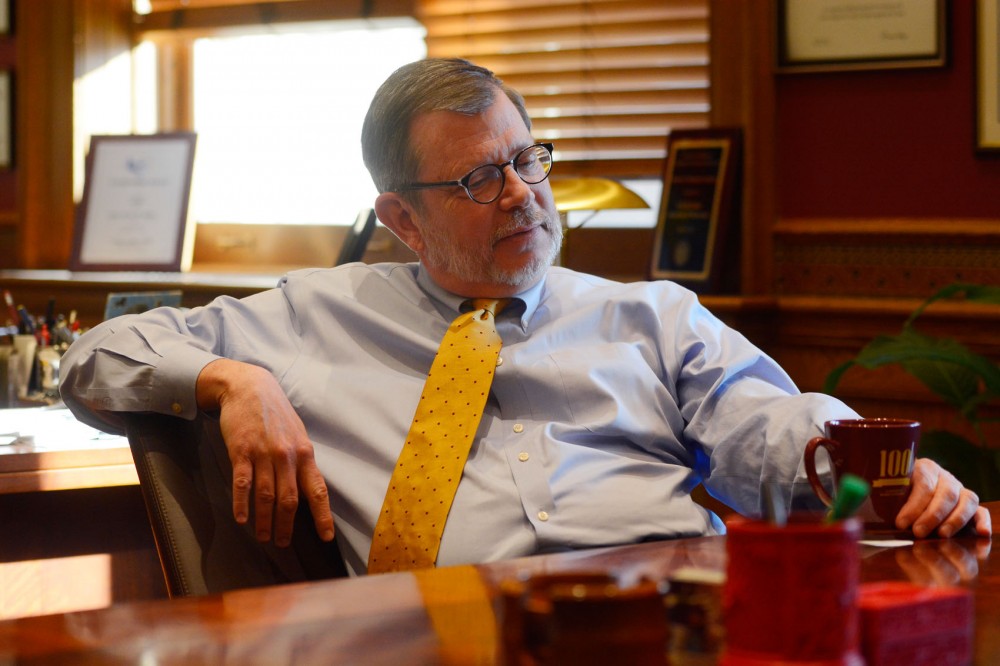The Minnesota Daily sat down with University of Minnesota President Eric Kaler on Friday, more than a week after Gov. Mark Dayton proposed to fund only one-quarter of what the school requested for its next budget cycle.
Kaler discussed the University’s budget request, a campus climate report and a piece of land the University is acquiring for a total of $26 million.
In Dayton’s budget proposal, he included half of the requested funding for the tuition freeze. How does the University plan to fund the other half of the tuition freeze included in Dayton’s proposal?
The game’s not over yet. We still have a legislative session to move through, and we’ll be articulating to the House and Senate the benefits of supporting the tuition freeze. I think it is politically popular, so it’s too early to know what the final budget will look like. …
We’re very grateful for the governor getting us halfway there, but we will need to find additional funding because I really do not want to raise tuition. But if that becomes necessary, then that will become necessary.
The governor’s budget request included about one-fourth of what the University originally requested. Will you be working with the governor and legislators to communicate to them why they should increase the amount?
That’s pretty much my everyday job. When the session is in, we spend a lot of time there. … [The University has] great programs that will be very impactful for … Minnesota. We are a terrific return on the state’s investment, and we think we have more to offer.
While the governor didn’t fund initiatives like “healthy Minnesota,” “vibrant communities” and the facility condition improvement strategy in his budget, he did propose $30 million in state funding for the Medical School. How does that make you feel?
We’re excited about that, and again, we’re grateful to the governor for his willingness to do that. That followed, of course, a Blue Ribbon Commission that generated some recommendations for moving the Medical School up in rankings. …
We’re pleased with that, and of course, it overlaps some of the requests that were in the “healthy Minnesota” piece. So we’ll realign that [request] so that we’re not double dipping.
Some lawmakers have said that they would like to see performance measures used for funding again next year. What do you think of that?
I think there’s a fine line between the legislative direction and the autonomy the University has that dates back to its founding. … I do think it’s important that the state invests in institutions that are graduating their students at a reasonable rate.
The ability or idea that a state invests in an institution that doesn’t produce graduates is a hard thing to understand.
Last month, the campus climate report was released. It was put together by a campus work group that looked at ways to make the campus welcoming to all. How will the University follow through on those recommendations?
We’ll take action on them. There’s 16 of them. We parsed out who’s responsible for moving on each one of those. Some of them will require some budget realignment and support … so we’ll do that. We had a good first step [Thursday] in a climate workshop that hundreds of people attended.
Is there a timeline for getting these recommendations in place?
Some of them will take longer than others, particularly when you look at faculty hiring. That’s a multi-year process. We can identify where the openings are, put together search committees and advertisements and interviews. Unfortunately, it’s a subject we can’t change instantly, but we’re going to work on it hard.
To continue to reduce its $12 million budget deficit from last year, the University of Minnesota-Duluth announced that it plans to further reduce the shortfall by $6 million over the next two years. What role does the University of Minnesota system play in helping UMD?
We try to provide as much help as we can, both in terms of expertise around budget analysis and planning and putting central dollars into Duluth, which we did last year. [We] will continue to look for opportunities to help.
[Duluth is] an important part of the University of Minnesota system. I want them to be successful, and an important part of that is getting them back in budget balance, and we’re trying to help them do that.
Are there any specific plans to shift funding to UMD?
We’re in the process of those budget negations right now, so we don’t have a particular plan for any of the collegiate units now, but those will develop as the semester moves forward.
The University recently purchased a block of property that’s part of a $26 million plan, but it has been said that there are no definitive plans for the land. What’s the rationale behind purchasing the land when there aren’t any definitive plans?
We purchase land strategically. That’s a block that’s located next to the Ambulatory Care Center. It’s a piece of property that doesn’t come on the market very often, so when it came on the market we thought it [was] important for long-term land use to buythat.
Valentine’s Day is coming up. Do you and Mrs. [Karen] Kaler have any plans set aside?
We have been married 35 years. That provides the opportunity for 35 Valentine’s Day activities. I do have a little surprise for her, but I’m not going to let her find out in the Daily what it is.


